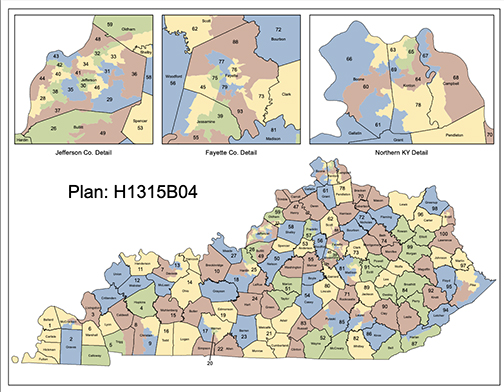How will the Kentucky Supreme Court’s redistricting ruling impact the state?
Published 4:27 pm Tuesday, January 2, 2024

- Kentucky’s current districting map, in place since 2022. It was drawn by a majority Republican legislature. (LRC)
Every decade, the Kentucky legislature re-draws electoral maps based on population shifts.
In 2022, the Republican-drawn maps drew scrutiny as partisan gerrymanders, or redistricted maps that clearly favor one political party over another.
Last month, the Kentucky Supreme Court ruled that partisan gerrymandering is constitutional, as long as it is not a “clear, flagrant and unwarranted violation of constitutional rights or so severe as threaten our democratic form of government.”
What is partisan gerrymandering?Partisan gerrymandering can include “cracking,” or splitting voters with a certain party affiliation between several electoral districts to dilute that party’s chances of winning seats.
It also includes “packing,” combining same-party voters or voters who may share similar characteristics into as few districts as possible to concentrate the party’s voting power in fewer districts, leaving room for the opposite party to win the rest.
Gerrymandering often leads to oddly shaped districts.
What is this case about?
In 2022, the Kentucky legislature passed House Bill 2, the state house electoral map, and Senate Bill 3, the congressional district map, over Gov. Beshear’s veto.
The Kentucky Democratic Party, State. Rep Derrick Graham and several voters immediately sued the state, current Secretary of State Michael Adams and the Kentucky Board of Elections, alleging that the new maps were drawn in a way that unconstitutionally benefited Republicans and hurt Democrats.
Section 33 of the Kentucky Constitution includes several requirements for redistricting maps, including population equality and county integrity, keeping counties together.
It also states that maps should not add part of one county to another whole county to make a district or divide counties, unless their population is too large for one district.
The plaintiffs alleged that HB2 split counties into three or more districts more than necessary, and had more districts consisting of one whole county and part of another than was strictly required considering Kentucky’s political geography.
The Democrat’s alternative map, House Bill 191, had some key differences.
It included 23 districts with portions of three or more counties, while HB2 included 31 such districts. HB191 further divided already split counties 60 times to HB2’s 80 times. And HB191 included 31 districts made up of a full county and a portion of another county, while HB2 included 45 such districts.
SB3 included an oddly shaped district, called the “Comer hook,” that extends from far western Kentucky to Frankfort in central Kentucky, where U.S. Rep. James Comer lives.
In 2022, the trial court ruled that while HB2 and SB3 were partisan gerrymanders, the consideration of partisan interest in the redistricting process was not explicitly forbidden in the Kentucky constitution.
This December, the Kentucky Supreme Court agreed.
What did the court say?
While there was some disagreement on the court over whether they should have taken up the case at all, only one justice disagreed on the substantive issue of partisan gerrymandering.
Justice Angela McCormick Bisig wrote the opinion of the court.
“Regardless of how unusual or eye-raising it may be, we must not erase it unless it plainly leaves the four corners of our constitutional frame,” she wrote.
The bar was high to rule the maps unconstitutional, McCormick said, because the Kentucky constitution specifically leaves the apportionment process to the legislative branch. Also, the court wants to be careful to not decide political questions intended to be under the purview of the other branches.
The court ruled that partisan gerrymandering in the 2022 maps does not rise to an unconstitutional level.
McCormick wrote that the difference between HB2 and HB191 was not significant enough – HB191 would have given Republicans an estimated 77 House seats while HB2 gave them 80.
“We note that every seat is important,” she wrote. “Even so, we simply cannot find that a disparity between HB2 and HB 191 of 3 out of 100 seats involves partisanship either rising to the level of a clear, flagrant and unwarranted violation of constitutional rights or so severe as threaten our democratic form of government.”
However, the court left room for a future challenge. McCormick said that theoretically, there could be a level of partisan redistricting that would be considered unconstitutional. The court declined to decide what that threshold might be.
How might this impact Kentucky?
Jazmin Smith, co-host of Democratic podcast My Old Kentucky Podcast, said that if these maps didn’t violate Section 33, it would be a difficult hurdle to find any partisan gerrymandered maps that reach an unconstitutional level.
She mentioned the Comer hook as an example.
“If that’s not a clear and flagrant violation, what is?” she asked.
“… I don’t know what’s the line in between the Frankfort hook map, which has been deemed constitutional, and districts that aren’t contiguous and completely don’t touch each other.”
Smith added that the court’s “approval” of the Section 33 deviation could potentially incentivize Republicans to go further in future map drawing to protect their party’s interests.
Former Republican Secretary of State Trey Grayson said this ruling confirmed how most members of his party always thought redistricting worked.
“Redistricting just historically has kind of been a partisan act,” Grayson said. “As they say, to the victors go the spoils, and you just have to do it inside the criteria of the Constitution.”
This gives Republicans more explicit permission to protect their incumbents during the next redistricting cycle, he added.
Grayson suggested that the court may have stopped short of drawing a line on how much partisan gerrymandering is too much out of deference for the separation of powers.
“In order to get to a partisan redistricting violating the constitution, you’ve probably got to really bring in some other elements of the Constitution,” he said.
Secretary of State Michael Adams said that the case was “much ado about nothing.”
“Not only do I agree with the court as a matter of constitutional law, but I actually found the lawsuit pretty offensive because the Democratic Party suddenly clutched their pearls and came out against partisan gerrymandering that they engaged in for 100 years,” he said.
Kentucky Democratic Party Chair Coleman Eldridge released a statement after the ruling.
“Today’s ruling reversing the lower court’s finding that these maps are extreme partisan gerrymanders – while deeply disappointing – will be an important bulwark against future efforts to draw more extreme partisan gerrymandered maps in Kentucky,” he wrote.
But while Chief Justice Laurance VanMeter is retiring next year, Grayson said that he doubts it will make future challenges any more likely to succeed.
“It doesn’t look like this is the kind of precedent that’s going to change anytime soon, just because the court composition changes,” he said.

